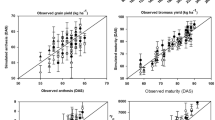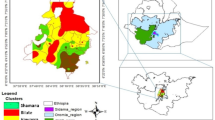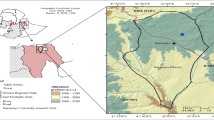Abstract
Climate change is currently considered the most important threat to sustainable development goals, particularly those goals related to the agricultural sector. The current research investigated sowing date as a strategy for adapting maize to climate change conditions in six sites of Kermanshah province characterized with a mild-arid climate using the SSM-Maize crop simulation model, HadGEM2-ES (the Hadley Centre Global Environmental Model version 2 Earth System configuration) climate model, and AgMIP (the Agricultural Model Intercomparison and Improvement Project) protocol under two emission scenarios (Representative Concentration Pathways: RCP4.5 and RCP8.5). Based on the simulation results, with temperatures rising (14% and 20% in RCP4.5 and RCP8.5, respectively) above the current threshold and CO2 concentrations increasing by 499 and 571 ppm in RCP4.5 and RCP8.5, respectively, maize yield in temperate and cold climates (all sites except Sarepol Zahab) under RCP4.5 and RCP8.5 scenarios will be decreased by -3.8% and − 6.5%, respectively. In Sarepol Zahab, the changes in air temperature and CO2 concentration increased maize yield by 11% and 21.7% in RCP4.5 and RCP8.5, respectively. Two factors influenced by climate change, namely growing season length and number of days with Tmax (maximum air temperature) ≥ 36 °C will play important roles in changing crop yield in the future. The results also showed that changing the sowing date along with increased CO2 concentration could reduce the adverse effects of climate change on maize by 15.6% across all sites, seasons, and scenarios. In fact, in all sites except Sarepol Zahab and Kangavar, sowing on the earliest possible date (April 3) helped the crop avoid encountering temperatures above 36 °C during the flowering period. In contrast, in Sarepol Zahab and Kangavar, as the hottest and coldest sites, respectively, delaying the sowing date (May 19 and June 4, respectively) could provide better conditions for crop growth. Overall, the findings of the current study showed that along with breeding activities, policy makers and extension agents of the agricultural sector can help farmers reduce the adverse effects of climate change on grain maize by compiling the cropping calendar and choosing the appropriate sowing date based on future climatic conditions.




Similar content being viewed by others
References
Abraha, M. G., & Savage, M. J. (2006). Potential impacts of climate change on the grain yield of maize for the midlands of KwaZulu-Natal, South Africa. Agriculture ecosystems & environment, 115(1–4), 150–160. https://doi.org/10.1016/j.agee.2005.12.020.
Acharjee, T. K., van Halsema, G., Ludwig, F., Hellegers, P., & Supit, I. (2019). Shifting planting date of Boro rice as a climate change adaptation strategy to reduce water use. Agricultural systems, 168, 131–143. https://doi.org/10.1016/j.agsy.2018.11.006.
Agricultural statistics (2022). Iranian Ministry of Agriculture Jihad. Center of Information and Communication Technology, Iran, p 92. Available online at https://www.maj.ir/Dorsapax/userfiles/Sub65/amarzeraei1400.pdf. (Accessed November 19, 2022).
Ahmadi, H., Ghalhari, G. F., & Baaghideh, M. (2019a). Impacts of climate change on apple tree cultivation areas in Iran. Climatic Change, 153(1), 91–103. https://doi.org/10.1007/s10584-018-2316-x.
Ahmadi, M., Dadashi Roudbari, A. A., Azirani, A., T., & Karami, J. (2019b). The performance of the HadGEM2-ES model in the evaluation of seasonal temperature anomaly of Iran under RCP scenarios. Journal of the Earth and Space Physics, 45(3), 625–644. https://doi.org/10.22059/jesphys.2019.279480.1007109. (In Persian with English abstract).
Amiri, S. R., Deihimfard, R., & Soltani, A. (2016). A single supplementary irrigation can boost chickpea grain yield and water use efficiency in arid and semiarid conditions: A modeling study. Agronomy Journal, 108(6), 2406–2416. https://doi.org/10.2134/agronj2016.02.0087.
Araya, A., Hoogenboom, G., Luedeling, E., Hadgu, K. M., Kisekka, I., & Martorano, L. G. (2015). Assessment of maize growth and yield using crop models under present and future climate in southwestern Ethiopia. Agricultural and forest Meteorology, 214, 252–265. https://doi.org/10.1016/j.agrformet.2015.08.259.
Baum, M. E., Licht, M. A., Huber, I., & Archontoulis, S. V. (2020). Impacts of climate change on the optimum planting date of different maize cultivars in the central US Corn Belt. European Journal of Agronomy, 119, 126101. https://doi.org/10.1016/j.eja.2020.126101.
Chen, X., Wang, L., Niu, Z., Zhang, M., & Li, J. (2020). The effects of projected climate change and extreme climate on maize and rice in the Yangtze River Basin, China. Agricultural and Forest Meteorology, 282, 107867. https://doi.org/10.1016/j.agrformet.2019.107867.
Chisanga, C. B., Phiri, E., Chinene, V. R., & Chabala, L. M. (2020). Projecting maize yield under local-scale climate change scenarios using crop models: Sensitivity to sowing dates, cultivar, and nitrogen fertilizer rates. Food and Energy Security, 9(4), e231. https://doi.org/10.1002/fes3.231.
Collins, W. J., Bellouin, N., Doutriaux-Boucher, M., Gedney, N., Hinton, T., Jones, C. D., Liddicoat, S., Martin, G., O’Connor, F., Rae, J., Senior, C., Totterdell, I., Woodward, S., Reichler, & Kim, J. (2008). Evaluation of the HadGEM2 model (p. 48). Exeter, UK: Met Office.
Dehghanpour (2014). Technical Guide for Corn Production (Grain and Forage). Publish of agricultural education: Seed and Plant Improvement Institute. https://agrilib.areeo.ac.ir/book_265.pdf (In Persian).
Dharmarathna, W. R. S. S., Herath, S., & Weerakoon, S. B. (2014). Changing the planting date as a climate change adaptation strategy for rice production in Kurunegala district, Sri Lanka. Sustainability science, 9(1), 103–111. https://doi.org/10.1007/s11625-012-0192-2.
Ghahreman, N., Tabatabaei, M., & Babaeian, I. (2015). Investigation of uncertainty in the IPCC AR5 precipitation and temperature projection over Iran under RCP Scenarios. Poster On Cop21-Cmp11, Paris.
Ghannoum, O., Caemmerer, S. V., Ziska, L. H., & Conroy, J. P. (2000). The growth response of C4 plants to rising atmospheric CO2 partial pressure: A reassessment. Plant Cell & Environment, 23(9), 931–942. https://doi.org/10.1046/j.1365-3040.2000.00609.x.
Godfray, H. C. J., Beddington, J. R., Crute, I. R., Haddad, L., Lawrence, D., Muir, J. F., Pretty, J., Robinson, S., Thomas, S. M., & Toulmin, C. (2010). Food security: the challenge of feeding 9 billion people. science, 327(5967), 812–818. https://doi.org/10.1126/science.1185383
Hu, Q., Yang, N., Pan, F., Pan, X., Wang, X., & Yang, P. (2017). Adjusting sowing dates improved potato adaptation to climate change in semiarid region, China. Sustainability, 9(4), 615. https://doi.org/10.3390/su9040615.
Hudson, N. I., & Ruane, A. C. (2013). Appendix 2. Guide for running AgMIP climate scenario generation tools with R in Windows, Version 2.3. In C. Rosenzweig, J. W. Jones, J. L. Hatfield, C. Z. Mutter, S. G. K. Adiku, A. Ahmad, Y. Beletse, B. Gangwar, D. Guntuku, J. Kihara, P. Masikati, P. Paramasivan, K. P. C. Rao, & L. Zubair (Eds.), Handbook of Climate Change and Agroecosystems: The Agricultural Model Intercomparison and Improvement Project (AgMIP) Integrated Crop and Economic assessments. London. UK: Imperial College Press.
Jalali, O., & Khanjar, S. (2009). Investigation of temperature fluctuations by using of time series and probability distribution (case study: Kermanshah). Geographic Space, 9(27), 115–132. (In Persian with English abstract)https://www.sid.ir/en/journal/viewpaper.aspx?id=168795.
Jazayeri Noushabadi, M. R., Asghari, J., Lahiji, H. S., & Hamidi, A. (2020). Assessment of genetic purity of iranian commercial maize hybrid seeds using DUS characteristics and microsatellite markers (SSR). Seed Science and Technology, 8(2), 29–240. https://doi.org/10.22034/ijsst.2019.123777.1234. (In Persian with English abstract).
Kim, S. H., Gitz, D. C., Sicher, R. C., Baker, J. T., Timlin, D. J., & Reddy, V. R. (2007). Temperature dependence of growth, development, and photosynthesis in maize under elevated CO2. Environmental and experimental botany, 61(3), 224–236. https://doi.org/10.1016/j.envexpbot.2007.06.005.
Kimball, B. A., Kobayashi, K., & Bindi, M. (2002). Responses of agricultural crops to free-air CO2 enrichment. Advances in agronomy, 77, 293–368. https://doi.org/10.1016/S0065-2113(02)77017-X.
Kipkulei, H. K., Bellingrath-Kimura, S. D., Lana, M., Ghazaryan, G., Baatz, R., Boitt, M., Chisanga, C. B., Rotich, B., & Sieber, S. (2022). Assessment of maize yield response to agricultural management strategies using the DSSAT-CERES-Maize model in Trans Nzoia county in Kenya. International Journal of Plant Production, 16(4), 557–577. https://doi.org/10.1007/s42106-022-00220-5.
Lashkari, A., Alizadeh, A., Rezaei, E. E., & Bannayan, M. (2012). Mitigation of climate change impacts on maize productivity in northeast of Iran: A simulation study. Mitigation and adaptation strategies for global change, 17, 1–16. https://doi.org/10.1007/s11027-011-9305-y.
Laux, P., Jäckel, G., Tingem, R. M., & Kunstmann, H. (2010). Impact of climate change on agricultural productivity under rainfed conditions in Cameroon—A method to improve attainable crop yields by planting date adaptations. Agricultural and Forest Meteorology, 150(9), 1258–1271. https://doi.org/10.1016/j.agrformet.2010.05.008.
Leakey, A. D., Bernacchi, C. J., Dohleman, F. G., Ort, D. R., & Long, S. P. (2004). Will photosynthesis of maize (Zea mays) in the US Corn Belt increase in future [CO2] rich atmospheres? An analysis of diurnal courses of CO2 uptake under free-air concentration enrichment (FACE). Global Change Biology, 10(6), 951–962. https://doi.org/10.1111/j.1529-8817.2003.00767.x.
Lobell, D. B., Hammer, G. L., Chenu, K., Zheng, B., McLean, G., & Chapman, S. C. (2015). The shifting influence of drought and heat stress for crops in northeast Australia. Global change biology, 21(11), 4115–4127. https://doi.org/10.1111/gcb.13022.
Lv, Z., Li, F., & Lu, G. (2020). Adjusting sowing date and cultivar shift improve maize adaption to climate change in China. Mitigation and Adaptation Strategies for Global Change, 25(1), 87–106. https://doi.org/10.1007/s11027-019-09861-w.
Manschadi, A. M., Eitzinger, J., Breisch, M., Fuchs, W., Neubauer, T., & Soltani, A. (2021). Full parameterisation matters for the best performance of crop models: Inter-comparison of a simple and a detailed maize model. International Journal of Plant Production, 15(1), 61–78. https://doi.org/10.1007/s42106-020-00116-2.
Meza, F. J., Silva, D., & Vigil, H. (2008). Climate change impacts on irrigated maize in Mediterranean climates: Evaluation of double cropping as an emerging adaptation alternative. Agricultural systems, 98(1), 21–30. https://doi.org/10.1016/j.agsy.2008.03.005.
Nehbandani, A., Soltani, A., Taghdisi Naghab, R., Dadrasi, A., & Alimagham, S. M. (2020). Assessing HC27 soil database for modeling plant production. International Journal of Plant Production, 14, 679–687. https://doi.org/10.1007/s42106-020-00114-4.
Prescott, J. A. (1940). Evaporation from a water surface in relation to solar radiation. Transactions of the Royal Society of South Australia, 46, 114–118.
Prins, A., Verrier, P., Kunert, K. J., & Foyer, C. (2007). Acclimation of the maize transcriptome to CO2 enrichment. South African Journal of Botany, 73, 307–308.
Rahimi-Moghaddam, S., & Azizi, K. (2018). Early sowing date as a strategy for improvement of maize yield and maize physiological and phonological characteristics in climate change conditions at Kermanshah Province. Journal of Crop Production, 10(4), 91–105. https://doi.org/10.22069/ejcp.2018.12078.1930. (In Persian with English abstract).
Rahimi-Moghaddam, S., Kambouzia, J., & Deihimfard, R. (2019). Optimal genotype× environment× management as a strategy to increase grain maize productivity and water use efficiency in water-limited environments and rising temperature. Ecological Indicators, 107, 105570. https://doi.org/10.1016/j.ecolind.2019.105570.
Rockström, J. (2003). Water for food and nature in drought–prone tropics: Vapour shift in rain–fed agriculture. Philosophical Transactions of the Royal Society of London Series B: Biological Sciences, 358(1440), 1997–2009. https://doi.org/10.1098/rstb.2003.1400.
Rosenzweig, C., Elliott, J., Deryng, D., Ruane, A. C., Müller, C., Arneth, A., Boote, K. J., Folberth, C., Glotter, M., Khabarov, N., & Neumann, K. (2014). Assessing agricultural risks of climate change in the 21st century in a global gridded crop model intercomparison. Proceedings of the national academy of sciences, 111(9), 3268–3273. https://doi.org/10.1073/pnas.1222463110
Roudier, P., Sultan, B., Quirion, P., & Berg, A. (2011). The impact of future climate change on west african crop yields: What does the recent literature say? Global environmental change, 21(3), 1073–1083. https://doi.org/10.1016/j.gloenvcha.2011.04.007.
Ruane, A., McDermid, S., Hudson, N., Rosenzweig, C., Ahuja, L. R., Anapalli, S. S., Anothai, J., Asseng, S., Dumont, B., Bert, F., & Bertuzzi, P. (2013). The coordinated climate-crop modeling project (C3MP). Singapore: World Scientific Publishing Co Pte Ltd.
Saddique, Q., Cai, H., Xu, J., Ajaz, A., He, J., Yu, Q., Wang, Y., Chen, H., Khan, M. I., Liu, D. L., & He, L. (2020). Analyzing adaptation strategies for maize production under future climate change in Guanzhong Plain, China. Mitigation and adaptation strategies for global change, 25(8), 1523–1543. https://doi.org/10.1007/s11027-020-09935-0.
Sánchez, B., Rasmussen, A., & Porter, J. R. (2014). Temperatures and the growth and development of maize and rice: A review. Global change biology, 20(2), 408–417. https://doi.org/10.1111/gcb.12389.
Semenov, M. A., & Stratonovitch, P. (2015). Adapting wheat ideotypes for climate change: Accounting for uncertainties in CMIP5 climate projections. Climate Research, 65, 123–139. https://doi.org/10.3354/cr01297.
Soltani, A., & Sinclair, T. R. (2012). Optimizing chickpea phenology to available water under current and future climates. European journal of agronomy, 38, 22–31. https://doi.org/10.1016/j.eja.2011.11.010.
Soltani, A., Alimagham, S. M., Nehbandani, A., Torabi, B., Zeinali, E., Zand, E., Vadez, V., Van Loon, M. P., & Van Ittersum, M. K. (2020). Future food self-sufficiency in Iran: A model-based analysis. Global Food Security, 24, 100351. https://doi.org/10.1016/j.gfs.2020.100351.
Tian, B., Zhu, J., Nie, Y., Xu, C., Meng, Q., & Wang, P. (2019). Mitigating heat and chilling stress by adjusting the sowing date of maize in the North China Plain. Journal of Agronomy and Crop Science, 205(1), 77–87. https://doi.org/10.1111/jac.12299.
Turral, H., Burke, J. J., & Faurès, J. M. (2011). Climate Change, Water and Food Security (36No. vol.). Rome: Food and agriculture organization of the United nations (FAO).
Van Wart, J., van Bussel, L. G., Wolf, J., Licker, R., Grassini, P., Nelson, A., Boogaard, H., Gerber, J., Mueller, N. D., Claessens, L., & van Ittersum, M. K. (2013). Use of agro-climatic zones to upscale simulated crop yield potential. Field crops research, 143, 44–55. https://doi.org/10.1016/j.fcr.2012.11.023.
Vanaja, M., Maheswari, M., Jyothi Lakshmi, N., Sathish, P., Yadav, S. K., Salini, K., Vagheera, P., Kumar, V., G., & Razak, A. (2015). Variability in growth and yield response of maize genotypes at elevated CO2 concentration. Advances in Plants & Agriculture Research, 2(2), 00042. https://doi.org/10.15406/apar.2015.02.00042.
Wilbanks, T. J., Kane, S. M., Leiby, P. N., Perlack, R. D., Settle, C., Shogren, J. F., & Smith, J. B. (2003). Possible responses to global climate change: Integrating mitigation and adaptation. Environment: Science and policy for sustainable development, 45(5), 28–38. https://doi.org/10.1080/00139150309604547.
Xiao, D., Liu, D. L., Wang, B., Feng, P., Bai, H., & Tang, J. (2020). Climate change impact on yields and water use of wheat and maize in the North China Plain under future climate change scenarios. Agricultural Water Management, 238, 106238. https://doi.org/10.1016/j.agwat.2020.106238.
Zeinali, E., Soltani, A., & Khadempir, M. (2015). Parameterization of SSM-Maize model for growth and yield simulation in Golestan province. Research Report. Gorgan University of Agricultural Sciences and Natural Resources. PP. 91. (In Persian).
Zhang, X., Cheng, J., Wang, B., Yan, P., Dai, H., Chen, Y., & Sui, P. (2019). Optimum sowing dates for high-yield maize when grown as sole crop in the North China Plain. Agronomy, 9(4), 198. https://doi.org/10.3390/agronomy9040198.
Author information
Authors and Affiliations
Corresponding author
Additional information
Publisher’s Note
Springer Nature remains neutral with regard to jurisdictional claims in published maps and institutional affiliations.
Electronic Supplementary Material
Below is the link to the electronic supplementary material.
Rights and permissions
Springer Nature or its licensor (e.g. a society or other partner) holds exclusive rights to this article under a publishing agreement with the author(s) or other rightsholder(s); author self-archiving of the accepted manuscript version of this article is solely governed by the terms of such publishing agreement and applicable law.
About this article
Cite this article
Kafaie Ghaeini, A., Soltani, A., Deihimfard, R. et al. Modifying Sowing date as an Adaptation Strategy to Climate Change in Grain Maize (Zea mays L.) Under mild-arid Climates as Simulated by the SSM-Maize Model. Int. J. Plant Prod. 17, 437–447 (2023). https://doi.org/10.1007/s42106-023-00252-5
Received:
Accepted:
Published:
Issue Date:
DOI: https://doi.org/10.1007/s42106-023-00252-5




